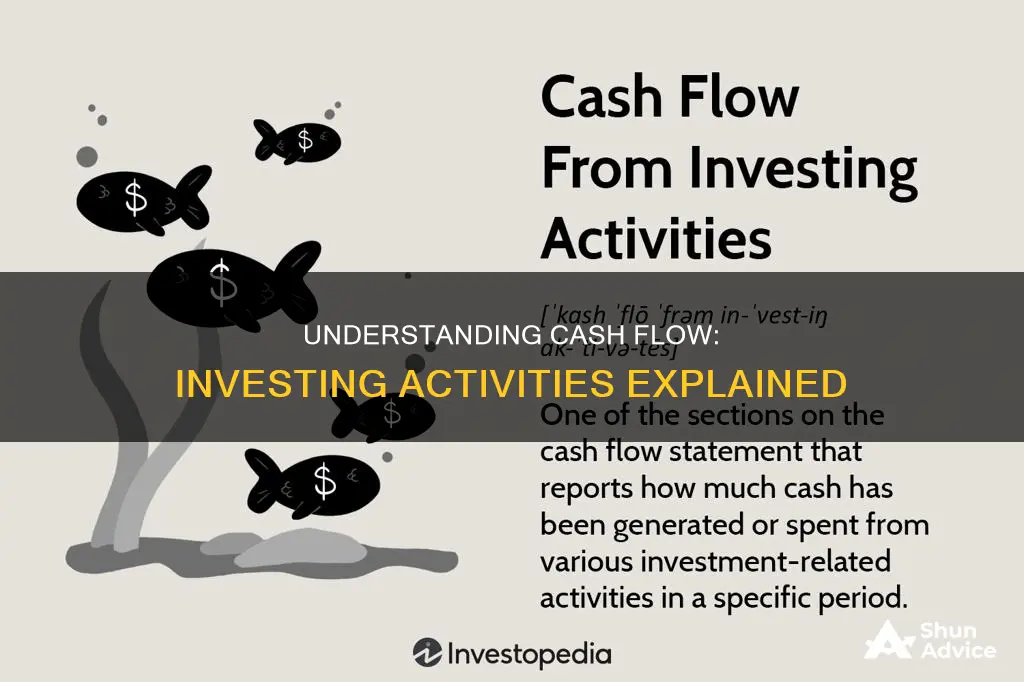
Cash flow from investing activities (CFI) is one of the sections of a company's cash flow statement. It reports the net amount of cash generated or lost from investment activities over a specific period. This includes the purchase and sale of investments, as well as earnings from investments. CFI is important as it shows how a company is allocating cash for the long term. It is also useful for measuring how effectively a company manages its cash from operating activities and its financing activities.
What You'll Learn

Long-term investments
- Property, plant, and equipment (PP&E): This includes capital expenditures on physical assets such as buildings, machinery, vehicles, or technology. PP&E is a significant component of a company's balance sheet and indicates its commitment to long-term growth.
- Marketable securities: Companies may invest in stocks, bonds, or other financial instruments to generate returns over the long term.
- Acquisitions of other businesses: Investing activities can also include the purchase of other companies or their divisions, which can provide strategic benefits such as expanded market share, access to new technologies, or synergies.
- Research and development: Negative cash flow from investing activities can indicate that a company is investing significantly in R&D, which may lead to future growth and gains.
Uncertain Future Cash Flows: Navigating Investment Project Analysis
You may want to see also

Capital expenditures
The purchase of PP&E is a core, recurring expenditure for most businesses. It is a critical component of a company's investing activities, as it involves investing in the long-term health and growth of the company. These expenditures are made to generate income in the future and are, therefore, an important indicator of a company's financial health and future prospects.
The cash flow statement is one of the three main financial statements used by companies, alongside the balance sheet and income statement. The cash flow statement bridges the gap between the income statement and the balance sheet by showing how much cash is generated or spent on operating, investing, and financing activities.
The cash flow statement is divided into three sections: cash flow from operating activities, cash flow from investing activities, and cash flow from financing activities. Capital expenditures are reported in the cash flow from investing activities section, which details the cash inflows and outflows related to fixed assets and long-term investments over a specific period.
A company's capital expenditures can be found by looking at the investing section of its cash flow statement. This section will detail the sources and uses of funds for investing activities, including capital expenditures, lending money, and the sale of investment securities.

Business acquisitions
When a company acquires another business, it may involve a significant outflow of cash, especially if the acquisition involves purchasing the target company's assets or paying a premium for its stock. This can lead to a negative cash flow from investing activities in the short term. However, acquisitions are often made with a focus on long-term strategic goals, such as expanding operations, gaining market share, or acquiring new technologies or talent.
On the other hand, if a company sells a division or subsidiary, it can result in a positive cash flow from investing activities. The proceeds from such a sale would be considered an inflow of cash.
It's worth noting that the impact of acquisitions on cash flow can be complex and depend on various factors, such as the structure of the deal, the payment terms, and the financial health of the acquired business.
In summary, business acquisitions play a crucial role in a company's cash flow from investing activities, reflecting its strategic decisions and providing insights into its growth and capital allocation strategies.

Marketable securities
For example, a company may choose to invest in marketable securities such as stocks to boost short-term profits. Alternatively, they may opt for long-term investments in bonds to support the company's growth and performance. These activities are reflected in the cash flow statement, which helps investors and analysts understand the financial health and strategy of the company.
The cash flow statement details the cash inflows and outflows from investing activities, including the purchase and sale of marketable securities. This information is crucial for assessing the company's allocation of resources and its potential for future growth. It provides insights into the company's investment strategies and their impact on cash flow, helping investors and analysts make informed decisions.
In summary, marketable securities are an integral part of investing activities, and their inclusion in the cash flow statement offers valuable insights into a company's financial management and long-term prospects.

Cash flow from investing activities formula
The formula for calculating the cash flow from investing activities is:
Cash Flow from Investing Activities = (Capital Expenditures) + (Purchase of Long-Term Investments) + (Business Acquisitions) – Divestitures
The items in parentheses are entered as negative values (i.e. cash outflow). For example, if a company spent $30 billion on capital expenditures, $5 billion on investments, and $1 billion on acquisitions, while also making $3 billion from the sale of investments, the calculation would be:
Cash Flow from Investing Activities = ($30 billion) + ($5 billion) + ($1 billion) – $3 billion = -$33 billion
A negative cash flow from investing does not always indicate poor financial health. It often means that the company is investing in long-term growth, such as research and development, which may lead to significant future gains if well-managed.
Frequently asked questions
Cash flow from investing activities (CFI) is a section of a company's cash flow statement that shows how much cash has been generated or spent from various investment activities over a specific period.
Investing activities include the purchase or sale of physical assets, investments in securities, or the acquisition or sale of other businesses.
There is no singular formula for calculating CFI, but a generally accepted formula is: Cash flow from investing activities = CapEx/purchase of non-current assets + marketable securities + business acquisitions - divestitures.







